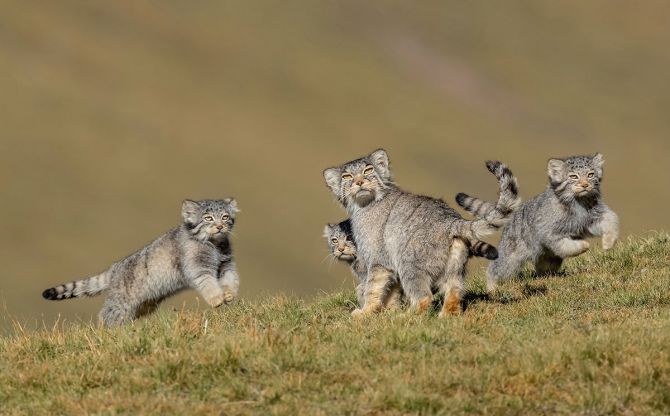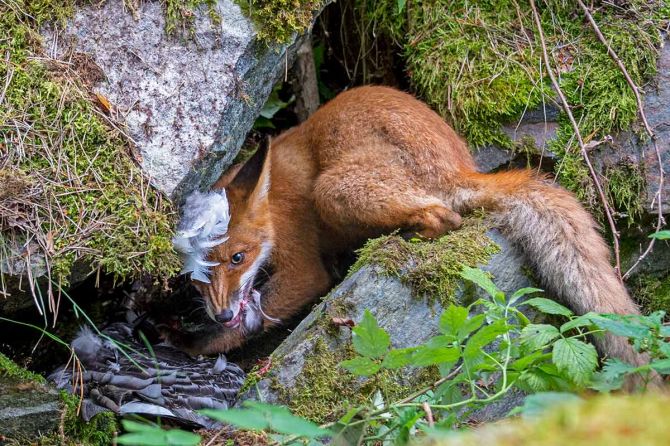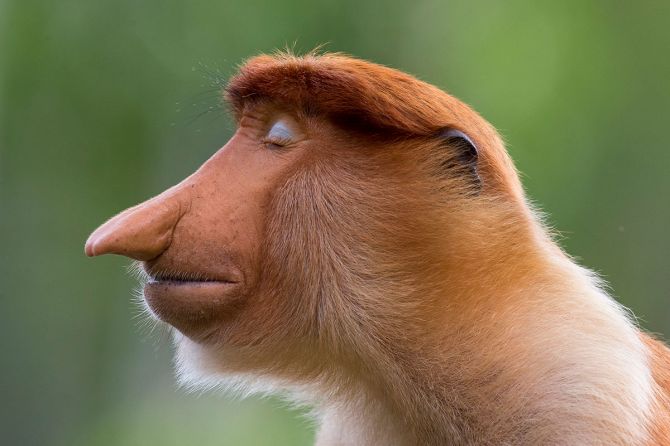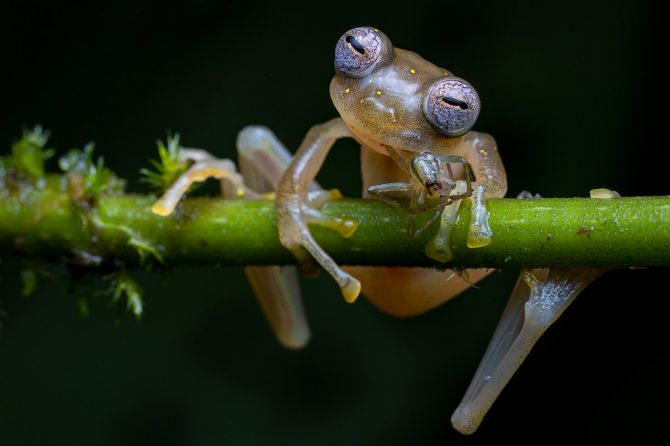Have a look at these photos taken from the incredible world we live in.
These are the winners of the Wildlife Photographer of the Year competition 2020.
The Duchess of Cambridge announced the award winners by an online live stream from the Natural History Museum.
This year's competition, the 56th annual contest, attracted 49,000 entries from around the world. The grand title winner was selected from a shortlist of 100 images 'spotlighting the world's richest habitats, fascinating animal behaviours and extraordinary species'.
The images will be showcased in lightbox displays at the Wildlife Photographer of the Year exhibition at the Natural History Museum, which opens on Friday, October 16.
Which is your favourite photo?
THE EMBRACE
Grand Title Winner

With an expression of sheer ecstasy, a tigress hugs an ancient Manchurian fir, rubbing her cheek against bark to leave secretions from her scent glands. She is an Amur, or Siberian, tiger, here in the Land of the Leopard National Park, in the Russian Far East. The race –now regarded as the same subspecies as the Bengal tiger -- is found only in this region, with a small number surviving over the border in China and possibly a few in North Korea. Scouring the forest for signs, focusing on trees along regular routes where tigers might have left messages–scent, hairs, urine or scratch marks -- he installed his first proper camera trap in January 2019, opposite this grandfir. But it was not until November that he achieved the picture he had planned for, of a magnificent tigress in her Siberian forest environment. Photograph: Sergey Gorshkov/Wildlife Photographer of the Year 2020
WHEN MOTHER SAYS RUN
Winner, Behaviour: Mammals

This rare picture of a family of Pallas’s cats, or manuls, on the remote steppes of the Qinghai–Tibet Plateau in northwest China is the result of six years’ work at high altitude. These small cats are normally solitary, hard to find and mostly active at dawn and dusk. Through long-term observation, Shanyuan knew his best chance to photograph them in daylight would be in August and September, when the kittens were a few months old and the mothers bolder and intent on caring for them. He tracked the family asthey descended to about 3,800metres (12,500 feet) in search of their favourite food–pikas (small, rabbit-like mammals)–and set up his hide on the hill opposite their lair, an old marmot hole. Hours of patience were rewarded when the three kittens came out to play, while their mother kept her eye on a Tibetan fox lurking nearby. Photograph: Shanyuan Li/Wildlife Photographer of the Year 2020
PERFECT BALANCE
Winner, 10 years and under

In spring, the meadows near Andrés’ home in Ubrique, in Andalucia, Spain, are bright with flowers, such as these sweet-scented sulla vetches. Andrés asked his dad to drive to the meadow and park so he could use the car as a hide, kneel on the back seat and, with his lens on the window sill, shoot through the open windows. He was delighted to see stonechats flying close by, alighting on any stem or stalk as a vantage point to look for worms, spiders and insects. It was already late in the day, and the sun had gone down, but it seemed that the low light intensified the birds’ colours. He watched this male closely. It often landed on branches or the top of small bushes, but this time it perched on a flower stem, which began to bend under its delicate weight. The stonechat kept perfect balance and Andrés framed his perfect composition. Photograph: Andres Luis Dominguez Blanco/Wildlife Photographer of the Year 2020
A MEAN MOUTHFUL
Winner, 11-14 years old

On a diving holiday in North Sulawesi, Indonesia, Sam stopped to watch the behaviour of a group of clownfishesas they swam with hectic and repeated patterns in and out and around their home, a magnificent anemone. Hewas intrigued by the expression of one individual, the result of its mouth being constantly open, holdingsomething. Rather than following the moving fish in his viewfinder, Sam positioned himself where he knew it would come back into the frame. Itwas only when he downloaded the photos that he saw tiny eyes peeping out of its mouth. It was a ‘tongue-eating louse’, a parasitic isopod that swims in through the gills as a male, changes sex, grows legs and attaches itself to the base of the tongue, sucking blood. When the tongue withers and drops off, theisopod takes its place. Photograph: Sam Sloss/Wildlife Photographer of the Year 2020
THE FOX THAT GOT THE GOOSE
Winner, Young Grand Title Winner

It was on a summer holiday in Helsinki that Liina, then aged 13, heard about a large fox family living in the city suburbs on the island of Lehtisaari. It was 7pm when the excitement began, with the vixen’s arrival with abarnacle goose. Feathers flew as the cubs began fighting over it. One finally gained ownership–urinating on it in its excitement. Dragging the goose into a crevice, the cub attempted to eat its prize while blocking access to the others. Lying just metres away, Liina was able to frame the scene and capture the expression of the youngster as it attempted to keep its hungry siblings at bay. Photograph: Liina Heikkinen/Wildlife Photographer of the Year 2020
THE POSE
Winner, Animal Portraits

A young male proboscis monkey cocks his head slightly and closes his eyes. Unexpected pale blue eyelids now complement his immaculately groomed auburn hair. He poses for a few seconds as if in meditation. He is a wild visitor to the feeding station at Labuk Bay Proboscis Monkey Sanctuary in Sabah, Borneo–‘the most laid-back character,’ says Mogens, who has been photographing primates worldwide for the past five years. Photograph: Mogens Trolle/Wildlife Photographer of the Year 2020
LIFE IN THE BALANCE
Winner, Behaviour: Amphibians and Reptiles

A Manduriacu glass frog snacks on a spider in the foothills of the Andes, northwesternEcuador. As big consumers of invertebrates, glass frogs play a keypart in maintaining balanced ecosystems. That night, Jaime’s determination to share his passion for them had driven him to walk for four hours, in heavyrain, through the forest to reach the frogs’ streams in Manduriacu Reserve.But the frogs were elusive and the downpour was growing heavier and heavier. Ashe turned back, he was thrilled to spot one small frog clinging to a branch, its eyes like shimmering mosaics. Not only was it eating –he had photographed glassfrogs eating only once before -- but it was also a newly discovered species.Distinguished by the yellow spots on its back and lack of webbing between its fingers, the Manduriacu frog is found only in this small area. Photograph: Jaime Culebras/Wildlife Photographer of the Year 2020
GREAT CRESTED SUNRISE
Winner, Behaviour: Birds

After several hours up to his chest in water in a lagoon near Brozas, in the west of Spain, Jose Luiscaptured this intimate moment of a great crested grebe family. His camera floated on a U-shaped platform beneath the small camouflaged tent that also hid his head. The grebes are at their most elegant in the breeding season -- ornate plumage, crests on their heads, neck feathers that they can fan into ruffs, striking red eyes and pink-tinged bills. They build a nest of aquatic plant material, often among reeds at the edge of shallow water. To avoid predators, their chicks leave the nest within a few hours of hatching, hitching a snug ride on a parent’s back. Here the backlings will live for
the next two to three weeks, being fed as fast as their parents can manage. Even when a youngster has grown enough to be able to swim properly, it will still be fed, for many more weeks, until it fledges. This morning, the parent on breakfast duty -- after chasing fish and invertebrates underwater – emerged with damp feathers and a tasty meal, just when not a breath of wind rippled the water and the stripy-headed chick stretched out of its sanctuary, open‐beaked, to claim the fish. In soft light and muted reflections, Jose Luis was able to reveal the fine detail of these graceful birds and their attentive parental care.. Photograph: Jose Luis Ruiz Jiménez/Wildlife Photographer of the Year 2020
A TALE OF TWO WASPS
Winner, Behaviour: Invertebrates

This remarkable simultaneous framing of a red-banded sand wasp (left) and a cuckoo wasp, about to enter next-door nest holes, is the result of painstaking preparation. Though these two species don’t regularly interact, Frank was gifted a perfectly balanced composition by the insects’ fortuitous flight paths to their nest holes. Photograph: Frank Deschandol/Wildlife Photographer of the Year 2020
THE GOLDEN MOMENT
Winner, Under Water

A tiny diamondback squid paralarva flits below in the blackness, stops hunting for an instant when caught in the light beam, gilds itself in shimmering gold andthen moves gracefully out of the light. The beam was Songda’s, on a night-dive over deep water, far off the coast of Anilao, in the Philippines. Photograph: Songda Cai/Wildlife Photographer of the Year 2020
WATCHING YOU WATCHING THEM
Winner, Urban Wildlife

What a treat for a biologist: the species you want to study chooses to nest right outside your window. The Cordilleran flycatcher is declining across western NorthAmerica as the changing climate causes shrinkage of the riparian habitats (river and other freshwater corridors) along its migratory routes and on its wintering grounds in Mexico. But one pair picked this remote research cabin instead, perhaps to avoid predation. Thenest was built on the head of a window frame by the female. She made it out of moss, grass and other plant material and lined it with finer fibres, hair and feathers. Both parents were feeding the nestlings, flying out to snatch insects in mid-air or hovering to pick them off leaves. Soas not to disturb the birds, or attract predators to the nest, Alex hid his camera behind a large piece of bark on an ancient spruce tree leaning against the cabin. Hedirected a flash towards the trunk (so the scene would be illuminated by reflection) and operated the set-up remotely from the cabin. He captured his shot as the female paused to check on her four nestlings (at 12 days old, they will probably fledge in a few days). Behind her -- the cabin serving as a conveniently spacious hide–the biologist recorded his observations. Photograph: Alex Badyaev/Wildlife Photographer of the Year 2020
ETNA'S RIVER OF FIRE
Winner, Earth's Environments

From a great gash on the southern flank of MountEtna, lava flows within a huge lava tunnel, re-emerging further down the slope as an incandescent red river, veiled in volcanic gases. To witness the scene, Luciano and his colleagues had trekked for several hours up the north side of the volcano, through stinking steam and over ash-covered chaotic rocky masses –the residues of past eruptions. A wall of heat marked the limit of their approach. Luciano describes the show that lay before him as hypnotic, the vent resembling ‘an open wound on the rough and wrinkled skin of a huge dinosaur’. It was 2017, and he had been on the nearby island of Stromboli to photograph eruptions there when he heard news of the new vent on what is Europe’s largest volcano. He took the very next ferry, hoping he would arrive in time to see the peak of the latest show. hat Luciano most wanted to capture was the drama of the lava river flowing into the horizon. The only way to do that was to wait until just after sunset–‘the blue hour’–when contrasting shadows would cover the side of the volcano and, with a long exposure, he could set the incandescent flow against the blue gaseous mist to capture ‘the perfect moment’. Photograph: Luciano Gaudenzio/Wildlife Photographer of the Year 2020
SHOW BUSINESS
Winner, Wildlife Photojournalism: Single Image

One hand raised signalling the bear to stand, the other holding a rod, the trainer directs the ice-rink show. A wire muzzle stops the polar bear biting back, and blue safety netting surrounds the circus ring. It’s a shocking sight–not because of the massive predator towering over the petite woman in her ice-skating outfitbut because of the uneven power dynamic expressed by the posture of the bearand the knowledge that it is not performing by choice. But for the visitors to the travelling Russian circus -- here in the city of Kazan, Tatarstan -- it is entertainment. They are ignorant of how the polar bear has been trained and what it might endure behind the scenes -- including the fact that, when not performing, it probably spends most of its time in a transportation cage. For the photographer, who has spent a couple of years reporting on animal exploitation and abuse, this was the most symbolically shocking of all the scenes of exploitation she has shot, featuring as it does such an Arctic icon of wildness. Photograph: Kirsten Luce/Wildlife Photographer of the Year 2020
ELEONORA'S GIFT
Winner, Rising Star Portfolio

On the steep cliffs of a Sardinian island, a male Eleonora’s falcon brings his mate food -- a small migrant, probably a lark, snatched from the sky as it flew over the Mediterranean. Alberto was watching from a hide on San Pietro Island, from where he could photograph the adults on their cliff-top perch. He couldn’t see the nest, which was a little way down the cliff in a crevice in the rocks, but he could watch the male (much smaller and with yellow around his nostrils) pass on his prey, observing that he always seemed reluctant to give up his catch without a struggle. Photograph: Alberto Fantoni/Wildlife Photographer of the Year 2020
THE LAST BITE
Winner, Wildlife Photographer of the Year Portfolio Award

These two ferocious predators don’t often meet. The giant riverine tiger beetlepursues prey on the ground, while weaver ants stay mostly in the trees–but if they do meet, both need to be wary. When an ant colony went hunting small insects on a dry riverbed in Buxa Tiger Reserve, West Bengal, India, a tiger beetle began to pick off some of the ants. In the heat of the midday sun, Ripan lay on the sand and edged closer. The beetle swiftly turned and, with its large, curved mandibles, snipped the ant in two, but the ant’s head and upper body remained firmly attached. ‘The beetle kept pulling at the ant’s leg,’ says Ripan, ‘trying to rid itself of the ant’s grip, but it couldn’t quite reach its head.’ He used flash to illuminate the lower part of the beetle, balancing this against the harsh sunlight, as he got his dramatic, eye-level shot. Photograph: Ripan Biswas/Wildlife Photographer of the Year 2020

















